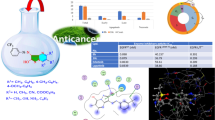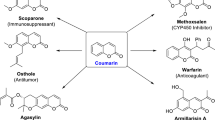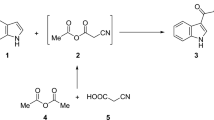Abstract
The current study evaluated the cytotoxic activity of 11(4-Aminophenylamino)neocryptolepine (APAN), a novel derivative of neocryptolepine, on hepatocellular (HepG2) and colon (HCT-116) carcinoma cell lines as well as, the possible molecular mechanism through which it exerts its cytotoxic activity. The APAN was synthesized and characterized based on their spectral analyses. Scanning for anticancer target of APAN by Swiss software indicated that APAN had highest affinity for protein tyrosine kinase 6 enzyme. Furthermore, Super pred software indicated that APAN can be indicated in hepatic and colorectal cells with 92%. Molecular docking studies indicated that the binding affinity scores of APAN for protein PDB code: 6CZ4 of tyrosine kinase 6 recorded of − 6.6084 and RMSD value of 0.8891°A, while that for protein PDB: 7JL7 of caspase 3 was − 6.1712 and RMSD of 0.8490°A. Treatment of HepG2 and HCT-116 cells with APAN induced cytotoxicity with IC50 of 2.6 and 1.82 μg/mL respectively. In addition, it induced injury and serious morphological changes in cells including, disappearance of microvilli, membrane blebbing, cytoplasmic condensation, and shrunken nucleus with more condensed chromatin. Moreover, APAN significantly increased protein expression of annexin V (apoptotic marker). Furthermore, APAN significantly increased protein expression of caspase 3 and P53. However, it significantly reduced secretion of VEGF protein into the medium and decreased protein expression of PCNA and Ki67 in HepG2 and HCT-116 cells. This study indicated that APAN had cytotoxic activity against HepG2 and HCT-116 cells via increasing the expression of apoptotic proteins and reducing the expression of proliferative proteins.









Similar content being viewed by others
Data availability
All data used in this study are included in this published article.
Abbreviations
- APAN:
-
11(4-AminoPhenylamnio)neocryptolepine
- DMF:
-
Dimethyl formamide
- HepG2:
-
Hepatocellular carcinoma
- HCT-116:
-
Colorectal carcinoma
- SRB:
-
Sulforhodamine (B)
- PCNA:
-
Proliferation cell nuclear antigen
- VEGF:
-
Vascular endothelial growth factor
6. References
Kamangar F, Dores GM, Anderson WF (2006) Patterns of cancer incidence, mortality, and prevalence across five continents: definingpriorities to reduce cancer disparities in different geographic regions of the world. J Clin Oncol 24:2137–2150
Ahmed A, Al-Mukhtar EJ, Ghaleb RA (2022) Antiproliferative activity of moringa oleifera’s leaves ethanolic extract and docetaxel on lncap cell line and on the level of tumor necrosis factorrelated apoptosis-inducing ligand. Int J Health Sci 6(S1):13569–13578
Zeeneldin AA, Ramadan M, Gaber AA, Taha FM (2013) Clinico-pathological features of breast carcinoma in elderly Egyptian patients: a comparison with the non-elderly using population–based data. J Egypt Natl Canc Inst 25:5–11
Bray F, Ferlay J, Soerjomataram I, Siegel RL, Torre LA, Jemal A (2018) Global cancer statistics: GLOBOCAN estimates of incidence and mortality worldwide for 36 cancers in 185 countries. CA Cancer J Clin 68:394–424
Health and Welfare Statistics Association (HWSA) (2013) Japan. J Health Welf Stat 60:51–75
Ibrahim AS, Khaled HM, Mikhail NN, Baraka H, Kamel H (2014) Cancer incidence in Egypt results of the national population-based cancer registry program. J Cancer Epidemiol 2014:437971
Elzoghby AO (2019) Pharmaceutical nanotechnology in Egypt: diverse applications and promising outcomes. Nanomedicine 14:649
Pawlotsky JM (2004) Pathophysiology of hepatitis C virus infection and related liverdisease. Trends Microbiol 12:96–102
Morgan TR, Mandayam S, Jamal MM (2004) Alcohol and hepatocellular carcinoma. Gastroenterology 127:S87–S96
Gao B, Bataller R (2011) Alcoholic liver disease: pathogenesis and new therapeutic targets. Gastroenterology 141(5):1572–1585
Trépo C, Chan HL, Lok, (2014) A Hepatitis B virus infection. Lancet 384(9959):2053–2063
Anstee QM, Reeves HL, Kotsiliti E, Govaere O, Heikenwalder M (2019) From NASH to HCC: current concepts and future challenges. Nat Rev Gastroenterol Hepatol 16(7):411–428
Zhang DY, Friedman SL (2012) Fibrosis-dependent mechanisms of hepatocarcinogenesis. Hepatology 56(2):769–775
Ahmed M (2020) Colon Cancer: a clinician’s perspective in 2019. Gastroenterol Res 13(1):1–10
Watson AJ, Collins PD (2011) Colon cancer: a civilization disorder. Dig Dis 29(2):222–228
Biller LH, Schrag D (2021) Diagnosis and treatment of metastatic colorectal cancer: a review. JAMA 325(7):669–685
Nagajyothi PC, Muthuraman P, Sreekanth TVM, Kim DH, Shim J (2017) Green synthesis: in-vitro anticancer activity of copper oxide nanoparticles against human cervical carcinoma cells. Arab J Chem 10(2):215–225
Lu Z, Chen H, Zheng XM, Chen ML (2017) Experimental study on the apoptosis of cervical cancer Hela cells induced by juglone through c-Jun N-terminal kinase/c-Jun pathway. Asian Pac J Trop Med 10(6):572–575
Mukherjee S (2010) The emperor of all maladies: a biography of cancer. Simon and Schuster Inc., New York
Schirrmacher V (2019) From chemotherapy to biological therapy: a review of novel concepts to reduce the side effects of systemic cancer treatment (Review). Int J Oncol 54(2):407–419
Roy A, Jauhari N, Bharadvaja N (2018) Medicinal plants as a potential source of chemopreventive agents. Anticancer plants: natural products and biotechnological implements. Springer, Singapore, pp 109–139
El-Atrsh A, Tousson E, Elnahas EE, Massoud A, Al-Zubaidi M (2019) Ameliorative effects of spirulina and chamomile aqueous extract against mice bearing ehrlich solid tumor induced apoptosis. Asian Oncol Res J 2(1):1–17
Willcox M (2011) Improved traditional phytomedicines in current use for the clinical treatment of malaria. Planta Med 77(6):662–671
Wang N, Świtalska M, Wang L, Shaban E, Hossain MI, El Sayed IET, Wietrzyk J, Inokuchi T (2019) Structural modifications of nature-inspired indoloquinolines: a mini review of their potential antiproliferative activity. Molecules 24(11):2121
Emam SM, El Sayed IET, Ayad MI, Hathout HMR (2017) Synthesis, characterization and anticancer activity of new Schiff bases bearing neocryptolepine. J Mol Struct 1146:600–619
Okada M, Mei ZW, Hossain MI, Wang L, Tominaga T, Takebayashi T, Murakami M, Yasuda M, Shigehiro T, Kasa T (2016) Synthesis and in vitro cancer cell growth inhibition evaluation of 11-amino-modified 5-Me-indolo [2, 3-b] quinolines and their COMPARE analyses. Med Chem Res 25:879–892
Lu WJ, Wicht KJ, Wang L, Imai K, Mei ZW, Kaiser M, El Sayed IT, Egan TJ, Inokuchi T (2013) Synthesis and antimalarial testing of neocryptolepine analogues: addition of ester function in SAR study of 2,11-disubstituted indolo[2,3-b]quinolines. Eur J Med Chem 64:498–511
Shaban E, Wicht KJ, Wang N, Mei ZW, Hayashi I, El Gokha AAA, Inokuchi T (2015) Synthesis and antimalarial activity of some neocryptolepine analogues carrying a multifunctional linear and branched carbon-side chains. Heterocycles 89:1055–1064
El Bardicy S, El Sayed I, Yousif F, Van der Veken P, Haemers A, Augustyns K, Pieters L (2012) Schistosomicidal and molluscicidal activities of aminoalkylamino substituted neo- and norneocryptolepine derivatives. Pharm Biol 50(2):134–140
El Sayed I, Van der Veken P, Steert K, Dhooghe L, Hostyn S, Van Baelen G, Lemière G, Maes BU, Cos P, Maes L, Joossens J, Haemers A, Pieters L, Augustyns K (2009) Synthesis and antiplasmodial activity of aminoalkylamino-substituted neocryptolepine derivatives. J Med Chem 52(9):2979–88
Wang L, Lu W, Odawara T, Misumi R, Mei Z, Peng W, El-Sayed IE (2014) Improved synthesis and reaction of 11-chloroneocryptolepines, strategic scaffold for antimalaria agent, and their 6-methyl congener from indole-3-carboxylate. J Heterocycl Chem 51:1106–1114
El-Gokha AA, Boshta NM, Hussein MKA (2017) Synthesis and structure-activity relationships of novel neocryptolepine derivatives. Chem Res Chin Univ 33:373–377
Wang N, Wicht KJ, Shaban E, Ngoc TA, Wang M-Q, Hayashi I, Hossain MI, Takemasa Y, Kaiser M, El Sayed IET (2014) Synthesis and evaluation of artesunate–indoloquinoline hybrids as antimalarial drug candidates. Medchemcomm 5:927–931
Lu W-J, Świtalska M, Wang L, Yonezawa M, El-Sayed IE-T, Wietrzyk J, Inokuchi T (2013) In vitro antiproliferative activity of 11-aminoalkylamino-substituted 5 H-indolo [2, 3-b] quinolines; improving activity of neocryptolepines by installation of ester substituent. Med Chem Res 22:4492–4504
Ahmed AAS, Awad HM, El-Sayed IET, El Gokha AA (2020) Synthesis and antiproliferative activity of new hybrids bearing neocryptolepine, acridine and α-aminophosphonate scaffolds. J Iran Chem Soc 17:1211–1221
El Sayed IE, Ullah S, Al-Hartomy OA, Hasanein AM, Ahmed AAS, Kahilo KA, El-Naggar ME (2022) Synthesis, nanoformulations, and in vitro anticancer activity of N-substituted side chain neocryptolepine scaffolds. Molecules 27(3):1024
Daina A, Michielin O, Zoete V (2019) Swiss target prediction: updated data and new features for efficient prediction of protein targets of small molecules. Nucleic Acids Res 47:W357–W364
Gallo K, Goede A, Preissner R, Gohlke BO (2022) SuperPred 3.0: drug classification and target prediction-a machine learning approach. Nucleic Acids Res 50(W1):W726-31
Molecular Operating Environment (MOE) (2012) Chemical Computing Group Inc.: Montreal, QC, Canada p. 10
Qiu L, Levine K, Gajiwala KS, Cronin CN, Nagata A, Johnson E, Kraus M, Tatlock J, Kania R, Foley T, Sun S (2018) Small molecule inhibitors reveal PTK6 kinase is not an oncogenic driver in breast cancers. PLoS ONE 13(6):e0198374
Yao L, Swartz P, Hamilton PT, Clark AC (2021) Remodeling hydrogen bond interactions results in relaxed specificity of Caspase-3. Biosci Rep. https://doi.org/10.1042/BSR20203495
Elmongy EI, Altwaijry N, Attallah NGM, AlKahtani MM, Henidi HA (2022) In-silico screening of novel synthesized thienopyrimidines targeting Fms related receptor tyrosine kinase-3 and their in-vitro biological evaluation. Pharmaceuticals (Basel) 15(2):170
Elmongy EI, Attallah NGM, Altwaijry N, AlKahtani MM, Henidi HA (2021) Design and synthesis of new thiophene/thieno[2,3-d]pyrimidines along with their cytotoxic biological evaluation as tyrosine kinase inhibitors in addition to their apoptotic and autophagic induction. Molecules 27(1):123
Skehan P, Storeng R, Scudiero D, Monks A, McMahon J, Vistica D, Warren JT, Bokesch H, Kenney S, Boyd MR (1990) New colorimetric cytotoxicity assay for anticancer-drug screening. J Natl Cancer Inst 82(13):1107–12
Marks D, Belov L, Davey M, Davey R, Kidman A (1992) The MTT cell viability assay for cytotoxicity testing in multidrug-resistant human leukemic cells. Leuk Res 16:1165–1173
Amin BH, Amer A, Azzam M, Abd El-Sattar NEA, Mahmoud D, Al-Ashaal S, Al-Khalaf BA, Hozzein WN (2022) Antimicrobial and anticancer activities of Periplaneta americana tissue lysate: an in vitro study. J King Saud Univ Sci 34:102095
Moldovan GL, Pfander B, Jentsch S (2007) PCNA, the maestro of the replication fork. Cell 129(4):665–679
Berlin A, Castro-Mesta JF, Rodriguez-Romo L, Hernandez-Barajas D, González-Guerrero JF, Rodríguez-Fernández IA, González-Conchas G, Verdines-Perez A, Vera-Badillo FE (2017) Prognostic role of Ki-67 score in localized prostate cancer: a systematic review and meta-analysis. Urol Oncol 35:499
Schneider E, Montenarh M, Wagner P (1998) Regulation of CAK kinase activity by p53. Oncogene 17:2733–2741
Porter AG, Janicke RU (1999) Emerging roles of caspase-3 in apoptosis. Cell Death Differ 6(2):99–104
Millauer B, Shawver LK, Plate KH, Risau W, Ullrich A (1994) Glioblastoma growth inhibited in vivo by a dominant-negative Flk-1 mutant. Nature 367:576–579
Ghose AK, Herbertz T, Hudkins RL, Dorsey BD, Mallamo JP (2011) Knowledge-based, central nervous system (CNS) lead selection and lead optimization for CNS drug discovery. ACS Chem Neurosci 3(1):50–68
Balogh J, Victor D 3rd, Asham EH, Burroughs SG, Boktour M, Saharia A, Li X, Ghobrial RM, Monsour HP Jr (2016) Hepatocellular carcinoma: a review. J Hepatocell Carcinoma 5(3):41–53
Jemal A, Siegel R, Ward E, Murray T, Xu J, Smigal C, Thun MJ (2006) Cancer statistics, 2006. CA Cancer J Clin 56(2):106–130
Ansah C, Gooderham NJ (2002) The popular herbal antimalarial, extract of Cryptolepis sanguinolenta, is potently cytotoxic. Toxicol Sci 70(2):245–251
Zhu H, Gooderham NJ (2006) Mechanisms of induction of cell cycle arrest and cell death by cryptolepine in human lung adenocarcinoma a549 cells. Toxicol Sci 91(1):132–139
Irie HY, Shrestha Y, Selfors LM, Frye F, Iida N, Wang Z, Zou L, Yao J, Lu Y, Epstein CB, Natesan S, Richardson AL, Polyak K, Mills GB, Hahn WC, Brugge JS (2010) PTK6 regulates IGF-1-induced anchorage-independent survival. PLoS ONE 5(7):e11729
Gilic MB (1874) Tyner AL (2020) Targeting protein tyrosine kinase 6 in cancer. Biochim Biophys Acta Rev Cancer 2:188432. https://doi.org/10.1016/j.bbcan.2020.188432
Amer M. (2016) Improved Synthesis of Neocryptolepine-type Indoloquinolines: Applications for New Fluorescent Labelled Derivatives and Anticancer Activity Evaluations (Doctoral dissertation, The University of Manchester (United Kingdom)
Sebeka AH, Osman AM, El Sayed IE, El-Bahanasawy M, Tantawy MA (2017) Synthesis and antiproliferative activity of novel neocryptolepine-hydrazides hybrids. J App Pharm Sci 7(10):009–015
Ishiyama M, Tominaga H, Shiga M, Sasamoto K, Ohkura Y, Ueno K (1996) A combined assay of cell viability and in vitro cytotoxicity with a highly water-soluble tetrazolium salt, neutral red and crystal violet. Biol Pharm Bull 19(11):1518–1520
Sengupta S, Chowdhury S, Bosedasgupta S, Wright CW, Majumder HK (2011) Cryptolepine-induced cell death of Leishmania donovani promastigotes is augmented by inhibition of autophagy. Mol Biol Int 2011:187850
Altwaijry N, El-Ghlban S, El Sayed IE, El-Bahnsawye M, Bayomi AI, Samaka RM, Shaban E, Elmongy EI, El-Masry TA, Ahmed HMA, Attallah NGM (2021) In vitro and in vivo antitumor activity of indolo[2,3-b] quinolines, natural product analogs from neocryptolepine alkaloid. Molecules 26(3):754
Ansah C, Zhu H, Goderham NJ (2008) The mechanism of cryptolepine-induced cell death. J Pharmacol Toxicol 3(4):291–301
Ma YH, Ma WT, Zhou ZK, Huang X, Jiang XR, Du KJ, Sun MZ, Zhang H, Fang H, Zhao Y, Zhu HM, Liu HX, Chen P, Liu YQ (2022) Synthesis of 8-fluoroneocryptolepine and evaluation for cytotoxic activity against AGS cancer cells. J Nat Prod 85(4):963–971
Yadav P, Yadav R, Jain S, Vaidya A (2021) Caspase-3: a primary target for natural and synthetic compounds for cancer therapy. Chem Biol Drug Des 98(1):144–165
Schuler M, Green DR (2005) Transcription, apoptosis and p53: catch-22. Trends Genet 21(3):182–187
Dassonneville L, Lansiaux A, Wattelet A, Wattez N, Mahieu C, Van Miert S, Pieters L, Bailly C (2000) Cytotoxicity and cell cycle effects of the plant alkaloids cryptolepine and neocryptolepine: relation to drug-induced apoptosis. Eur J Pharmacol 409(1):9–18
Rodphon W, Laohapaisan P, Supantanapong N, Reamtong O, Ngiwsara L, Lirdprapamongkol K, Thongsornkleeb C, Khunnawutmanotham N, Tummatorn J, Svasti J, Ruchirawat S (2021) Synthesis of isocryptolepine-triazole adducts and evaluation of their cytotoxic activity. ChemMedChem 16(24):3750–3762
Hicklin DJ, Ellis LM (2005) Role of the vascular endothelial growth factor pathway in tumor growth and angiogenesis. J Clin Oncol 23(5):1011–27
Ferrara N, Gerber HP, LeCouter J (2003) The biology of VEGF and its receptors. Nat Med 9(6):669–676
Gerdes J, Stein H, Pileri S, Rivano MT, Gobbi M, Ralfkiaer E, Nielsen KM, Pallesen G, Bartels H, Palestro G et al (1987) Prognostic relevance of tumour-cell growth fraction in malignant non-Hodgkin’s lymphomas. Lancet 2(8556):448–9
Dowsett M, Nielsen TO, A’Hern R, Bartlett J, Coombes RC, Cuzick J, Ellis M, Henry NL, Hugh JC, Lively T, McShane L, Paik S, Penault-Llorca F, Prudkin L, Regan M, Salter J, Sotiriou C, Smith IE, Viale G, Zujewski JA, Hayes DF (2011) International Ki-67 in breast cancer working group assessment of Ki67 in breast cancer: recommendations from the International Ki67 in breast cancer working group. J Natl Cancer Inst 103(22):1656–64
Moldovan GL, Pfander B, Jentsch S (2007) PCNA, the maestro of the replication fork. Cell 129(4):665–79
Narkwa PW, Domfeh SA, Awandare G, Mutocheluh M (2021) Cryptolepine consolidates its anticancer potential by increasing the anti-cancer pathway genes and decreasing that of pro-cancer pathway genes. Doi:https://doi.org/10.21203/rs.3.rs-133186/v3
Carmeliet P, Dor Y, Herbert JM, Fukumura D, Brusselmans K, Dewerchin M, Neeman M, Bono F, Abramovitch R, Maxwell P, Koch CJ, Ratcliffe P, Moons L, Jain RK, Collen D, Keshert E (1998) Role of HIF-1alpha in hypoxia-mediated apoptosis, cell proliferation and tumour angiogenesis. Nature 394(6692):485–90
Vaupel P (2004) The role of hypoxia-induced factors in tumor progression. Oncologist 9(Suppl 5):10–17. https://doi.org/10.1634/theoncologist.9-90005-10
Wang GL, Semenza GL (1995) Purification and characterization of hypoxia-inducible factor 1. J Biol Chem 270(3):1230–7
Zheng Z, Xu T, Liu Z, Tian W, Jiang ZH, Zhu GY, Li T, Gao J, Bai LP (2022) Cryptolepine suppresses breast adenocarcinoma via inhibition of HIF-1 mediated glycolysis. Biomed Pharmacother 153:113319
Lu CM, Chen YL, Chen HL, Chen CA, Lu PJ, Yang CN, Tzeng CC (2010) Synthesis and antiproliferative evaluation of certain indolo[3,2-c]quinoline derivatives. Bioorg Med Chem 18(5):1948–57
Sidoryk K, Jaromin A, Edward JA, Świtalska M, Stefańska J, Cmoch P, Zagrodzka J, Szczepek W, Peczyńska-Czoch W, Wietrzyk J, Kozubek A, Zarnowski R, Andes DR, Kaczmarek Ł (2014) Searching for new derivatives of neocryptolepine: synthesis, antiproliferative, antimicrobial and antifungal activities. Eur J Med Chem 6(78):304–313
Håheim KS, Lindbäck E, Tan KN, Albrigtsen M, Urdal Helgeland IT, Lauga C, Matringe T, Kennedy EK, Andersen JH, Avery VM, Sydnes MO (2021) Synthesis and evaluation of the tetracyclic ring-system of isocryptolepine and regioiso-mers for antimalarial antiproliferative and antimicrobial activities molecules. Molecules 26(11):3268
Bailly C, Laine W, Baldeyrou B, De Pauw-Gillet MC, Colson P, Houssier C, Cimanga K, Van Miert S, Vlietinck AJ, Pieters L (2000) DNA intercalation, topoisomerase II inhibition and cytotoxic activity of the plant alkaloid neocryptolepine. Anticancer Drug Des 15(3):191–201
Godlewska J, Luniewski W, Zagrodzki B, Kaczmarek L, Bielawska-Pohl A, Dus D, Wietrzyk J, Opolski A, Siwko M, Jaromin A, Jakubiak A, Kozubek A, Peczyñska-Czoch W (2005) Biological evaluation of omega-(dialkylamino)alkyl derivatives of 6H-indolo[2,3-b]quinoline–novel cytotoxic DNA topoisomerase II inhibitors. Anticancer Res 25(4):2857–2868
Acknowledgements
The authors acknowledge funding from Princess Nourah bint Abulrahman University Researchers Supporting Project number (PNURSP2022R164), Princess Nourah bint Abulrahman University, Riyadh, Saudi Arabia.
Funding
This work was funded by Princess Nourah bint Abulrahman University Researchers Supporting Project Number (PNURSP2022R164), Princess Nourah bint Abulrahman University, Riyadh, Saudi Arabia.
Author information
Authors and Affiliations
Contributions
ETN, MAAE, AAEG and SMEG suggested the idea and the experimental design; ETN, ASA, EE, IE, EEES performed the experiment and wrote the draft of manuscript with the support of and MAAE; MAAE, EEES and SMEG supervised the implementation of the experiment and analyzed the results. All authors discussed the results and contributed to finalize the manuscript.
Corresponding author
Ethics declarations
Competing interests
The authors declared that there are no competing interests.
Ethical approval
Not applicable.
Additional information
Publisher's Note
Springer Nature remains neutral with regard to jurisdictional claims in published maps and institutional affiliations.
Rights and permissions
Springer Nature or its licensor (e.g. a society or other partner) holds exclusive rights to this article under a publishing agreement with the author(s) or other rightsholder(s); author self-archiving of the accepted manuscript version of this article is solely governed by the terms of such publishing agreement and applicable law.
About this article
Cite this article
Nagy, E.T., Ahmed, A.A.S., Elmongy, E.I. et al. Design and cytotoxic evaluation via apoptotic and antiproliferative activity for novel 11(4-aminophenylamino)neocryptolepine on hepatocellular and colorectal cancer cells. Apoptosis 28, 653–668 (2023). https://doi.org/10.1007/s10495-023-01810-y
Accepted:
Published:
Issue Date:
DOI: https://doi.org/10.1007/s10495-023-01810-y




